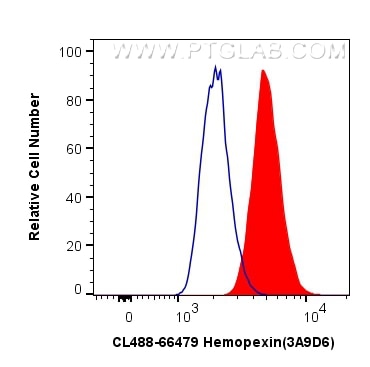Tested Applications
| Positive FC (Intra) detected in | HepG2 cells |
Recommended dilution
| Application | Dilution |
|---|---|
| Flow Cytometry (FC) (INTRA) | FC (INTRA) : 0.80 ug per 10^6 cells in a 100 µl suspension |
| It is recommended that this reagent should be titrated in each testing system to obtain optimal results. | |
| Sample-dependent, Check data in validation data gallery. | |
Product Information
CL488-66479 targets Hemopexin in FC (Intra) applications and shows reactivity with human samples.
| Tested Reactivity | human |
| Host / Isotype | Mouse / IgG1 |
| Class | Monoclonal |
| Type | Antibody |
| Immunogen |
CatNo: Ag8533 Product name: Recombinant human HPX protein Source: e coli.-derived, PGEX-4T Tag: GST Domain: 45-254 aa of BC005395 Sequence: DVTERCSDGWSFDATTLDDNGTMLFFKGEFVWKSHKWDRELISERWKNFPSPVDAAFRQGHNSVFLIKGDKVWVYPPEKKEKGYPKLLQDEFPGIPSPLDAAVECHRGECQAEGVLFFQGDREWFWDLATGTMKERSWPAVGNCSSALRWLGRYYCFQGNQFLRFDPVRGEVPPRYPRDVRDYFMPCPGRGHGHRNGTGHGNSICAVAHI Predict reactive species |
| Full Name | hemopexin |
| Calculated Molecular Weight | 254 aa, 29 kDa |
| Observed Molecular Weight | 65-75 kDa |
| GenBank Accession Number | BC005395 |
| Gene Symbol | Hemopexin |
| Gene ID (NCBI) | 3263 |
| RRID | AB_3084250 |
| Conjugate | CoraLite® Plus 488 Fluorescent Dye |
| Excitation/Emission Maxima Wavelengths | 493 nm / 522 nm |
| Form | Liquid |
| Purification Method | Protein G purification |
| UNIPROT ID | P02790 |
| Storage Buffer | PBS with 50% glycerol, 0.05% Proclin300, 0.5% BSA, pH 7.3. |
| Storage Conditions | Store at -20°C. Avoid exposure to light. Stable for one year after shipment. Aliquoting is unnecessary for -20oC storage. |
Background Information
Hemopexin (HPX) is the plasma protein responsible for scavenging heme, thus preventing heme-mediated oxidative stress and heme-bound iron loss. In addition, hemopexin blocks heme activation of immune receptors and vascular inflammatory processes. It is mainly expressed in liver, the synthesis of which is induced after inflammation. Alterations of plasma hemopexin level have been linked to disorders like atherosclerosis and inflammatory diseases.
Protocols
| Product Specific Protocols | |
|---|---|
| FC protocol for CL Plus 488 Hemopexin antibody CL488-66479 | Download protocol |
| Standard Protocols | |
|---|---|
| Click here to view our Standard Protocols |




